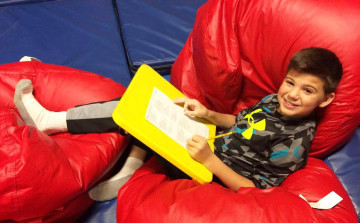Take a Mindful Minute: 5 Strategies To Help Complex Learners Use Mindfulness
Sunday, February 07, 2016
January is over, and those New Year’s resolutions you made going into 2016 might be taking a back seat to everything else you have to do. We all have good intentions, but let’s face it; there’s a lot on our plates these days.
Some mornings just getting out the door can make us feel hurried and stressed. But if you’re a parent or teacher of a child with complex learning issues, there’s one resolution you can make that won’t take a lot of time, and could have a big impact. You might want to consider adding a Mindful Minute to your day.
The practice of mindfulness, or paying close attention to the here and now in a purposeful manner, has received a lot of coverage in the news. Research has indicated that daily mindfulness can be attributed to a variety of positive outcomes including improved academics, reduced stress, cognitive flexibility and focus, increased compassion and even pain management.
GET THE LATEST BREAKING NEWS HERE -- SIGN UP FOR GOLOCAL FREE DAILY EBLASTComplex Learners struggle with a number of things that mindfulness helps address, including anxiety, difficulty organizing thoughts, and focus. It would seem a natural fit to engage Complex Learners in mindfulness, or what Jon Kabat-Zinn, the biologist who first coined the term, defines as a state of paying attention to our thoughts and feelings without judging them.
Huh?
That’s a reaction (along with a bit of eye rolling) you might expect to get from Complex Learners (and lots of adults) when given this definition. But here are a few ideas for integrating mindfulness into a child’s day at home or school in easy and helpful ways:
1) Start with a minute. And for some kids, even that may be too long. Sixty seconds of quiet without a specific task can feel like a long time to children who are distractible and anxious. At The Wolf School we use the phrase Mindful Minute, but it might last 30 seconds for younger students and 10 minutes for older or more practiced students. Have children start with a short period of time and work their way up.
2) Just breathe. Encourage children to focus on their breathing during their Mindful Minute to help create a calm and relaxed state. Students should try to breathe from their belly rather than from their chest, and to breathe in through their nose and out through their mouth. For some kids, placing their hands on their stomach gives them a tactile way to pay attention to breathing and helps them focus.
3) Listen to music. Playing slow-tempo music and focusing on the sound and vibration of each note is a great way to experience mindfulness for Complex Learners. New-age music or classical music work well, and if children start to think about other things, they can be reminded to acknowledge their thoughts and then gently bring their attention back to the music. A few minutes of peaceful music can help calm and relax even the most stressed of us.
4) Use guided practice. Sometimes it helps to have an exercise or activity that takes children through a sensory experience. Using a bell or meditation music, children can focus on a single sound and notice as it gets softer. Students can visualize a special place, or tap their thumb to each finger, narrowing their focus to the touch of their fingertips. Ask children to close their eyes and breathe in a scent (e.g., lavender, orange peel), focusing all of their attention only on the smell of that object. These activities can sharpen their senses, enhance memory, and feel calming to kids.
5) There’s an App for that. With mindfulness becoming mainstream, supports and resources are abundant. Search on-line for an app for your phone or guided meditations you can download to the computer or tablet. Calm.com is a favorite at The Wolf School, offering 2 to 20 minute guided meditations complete with beautiful nature scenes and soothing sounds.
Wolf students practice mindfulness school-wide on a daily basis. They use it as one of numerous strategies that help them get ready to learn. It’s become familiar and helpful, particularly before test taking or challenging tasks. According to one student, “It helps me relax because I’m not thinking that I’m going to get it wrong.”
It’s important to remember that the practice of mindfulness takes (you guessed it) practice. As a teacher or parent you can have fun sharing but also learning about mindfulness yourself. And as you know, the more you feel calm and relaxed, the easier it will be to positively engage your child. So take your own Mindful Minute and take care of yourself. It will help make up for all those other resolutions.
Anna Johnson is Head of School at The Wolf School in East Providence, a K-8 private special education school serving complex learners. www.thewolfschool.org
This series is a partnership between GoLocal and the Wolf School.
Related Articles
- GoLocalTV: How the Wolf School Helps Complex Learners
- Complex Learners: What to Look For
- Six Tips for Helping Complex Learners Manage Routines
- You’ve Got a Friend: 7 Tips for Helping Complex Learners Make and Keep Friends
- No More Holi-daze: 6 Tips for Happier Holidays with Complex Learners
- Move to Learn: 5 Types of Movement that Support Complex Learners




